| Uncle Al's 2021-2024
Racing Rules in Pics Definitions are quoted, then illustrated and explained as seems necessary. Definitions for instant access without scrolling, click on the selected definitions list below Leeward and Windward Tack, Starboard or Port Clear Astern and Clear Ahead; Overlap Racing Tacking Room Mark-Room Keep Clear Proper Course Obstruction Fetch Finish There are more
definitions but these do not lend themselves
easily to illustration. For the complete list and text
of Definitions in the RRS, click here.
. |
| Leeward and Windward A boat's leeward side is the side that is or, when she is head to wind, was away from the wind. However, when sailing by the lee or directly downwind, her leeward side is the side on which her mainsail lies. The other side is her windward side. When two boats on the same tack overlap, the one on the leeward side of the other is the leeward boat. The other is the windward boat. |
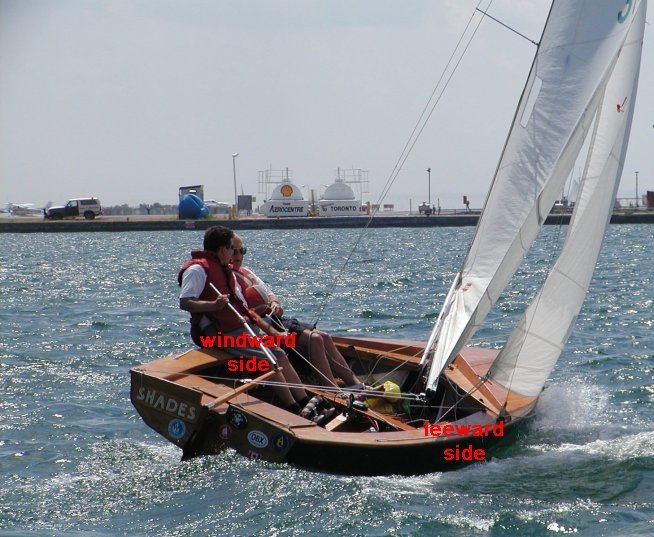 |
|
In essence, the leeward
side of the boat is the side on which the mainsail
is (or was, if you're head to wind). The other side is -
obviously? - the windward side.
... |
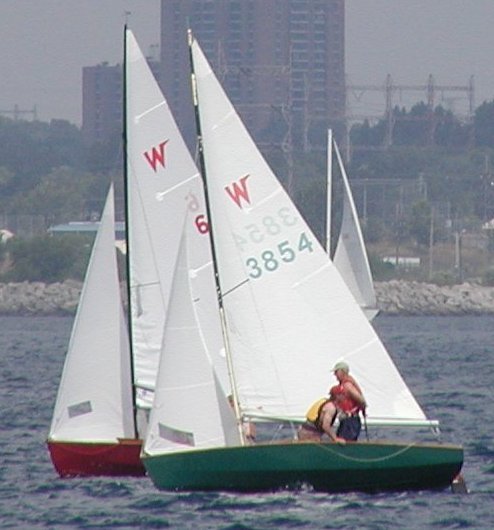 |
|
Since Heider Funck in W6
is overlapped with W3854 (Uncle Al) and off
Al's leeward side, W6 is the leeward boat
and Uncle Al is the windward boat - oddly
enough.
... |
| Tack, Starboard or Port A boat is on the tack, starboard or port, corresponding to her windward side. |
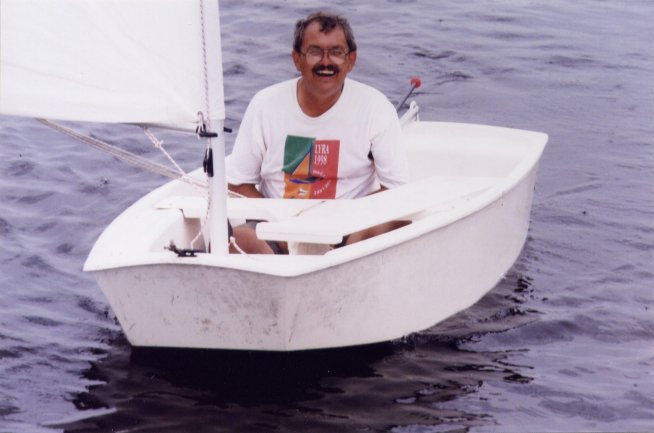 |
|
When you face the bow of
the boat, the side to your right is the starboard side,
and the left side is the port side. Here the
left (port) side of John Weakley's Opti is
her windward side, and she is thus on port
tack.
... |
| Clear Astern and Clear Ahead; Overlap One boat is clear astern of another when her hull and equipment in normal position are behind a line abeam from the aftermost point of the other boat's hull and equipment in normal position. The other boat is clear ahead. They overlap when neither is clear astern. However, they also overlap when a boat between them overlaps both. These terms always apply to boats on the same tack. They apply to boats on opposite tacks only when rule 18 applies between them or when both boats are sailing more than ninety degrees from the true wind. |
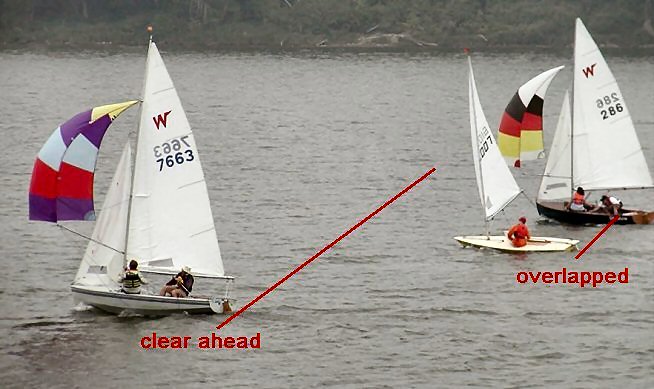 |
|
W7663 is clear ahead
of Laser 61007 and W286 since the latter are behind
an imaginary line drawn at a 90º angle to the centreline
of W7663 (i.e. abeam) through the aftermost tip of
W7663's rudder blade (i.e. the aftermost point of her
hull and equipment in normal position). Even if a
brightly visible spinnaker sheet, for example, was
dragging several metres behind W7663, the other two
boats would still not be overlapped with 7663 since that
would be equipment not in its normal position.
... |
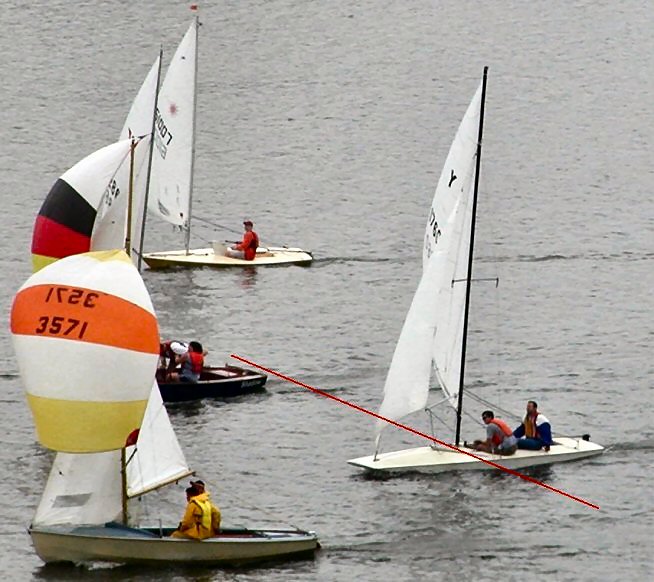 |
|
Y-Flyer 1760 (r)
is overlapped with Peter Rahn (black hull)
since not all of his hull and equipment are aft of the
(imaginary) line drawn abeam from the aftermost point of
Peter's hull and equipment (in normal position).
... |
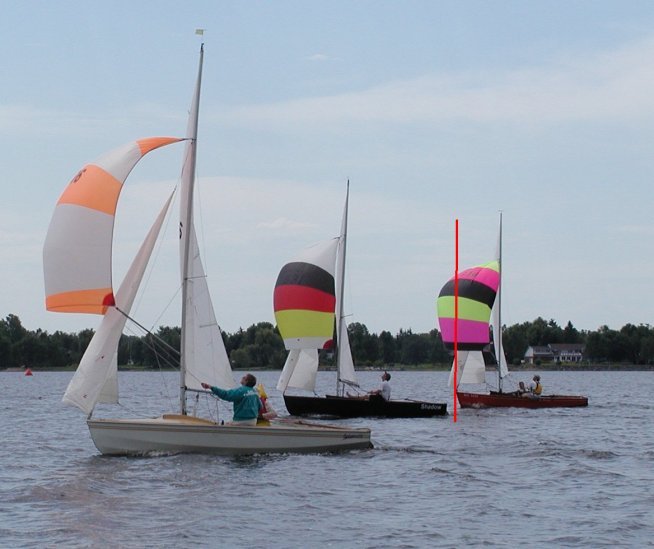 |
|
The red vertical line
through Hans Gottschling's spinnaker in the above photo
illustrates that the bow is not necessarily the
forewardmost part of a boat's hull and equipment. For
example, on a spinnaker run, a boat whose bow is a few
centimetres short of gaining an overlap, may
well have that crucial overlap due to her
spinnaker.
... |
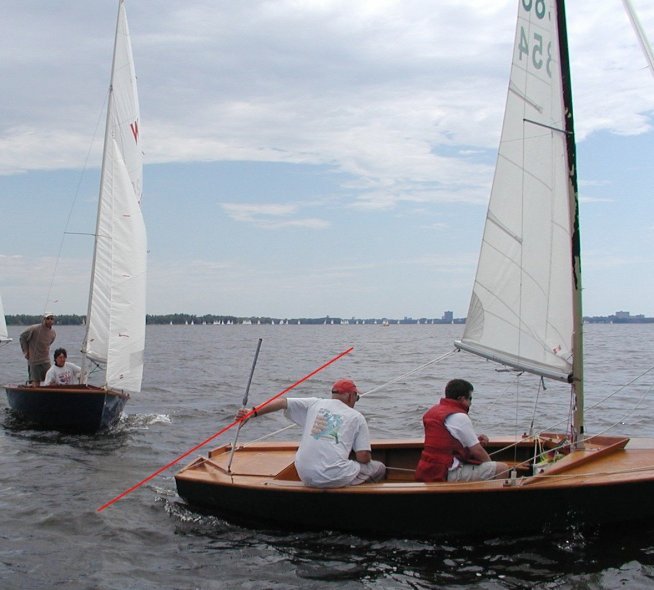 |
|
The sharp turn Uncle Al
is initiating on the starting line above, will soon give
Doug Netherton (left) a leeward overlap as
the red line swings around dramatically with the aft
part of Al's boat.
... |
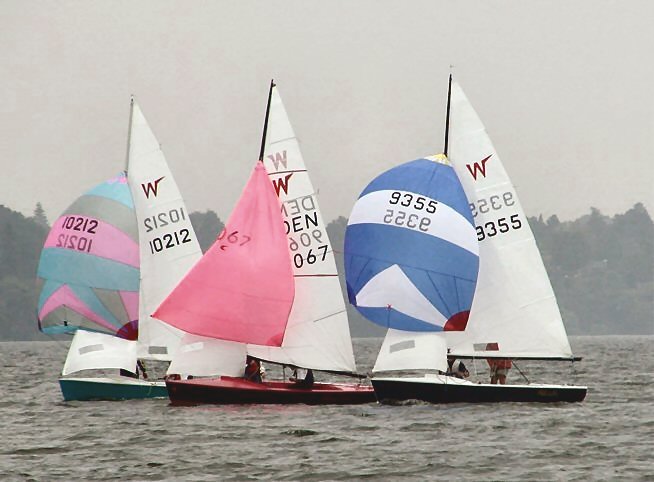 |
|
Above, Uncle Al (9355)
has an overlap on Søren Jensen (10212) because
Sten Madsen (9067) is between them and overlaps
both 10212 and 9355. Just in time to get buoy room it
was, too!!
... |
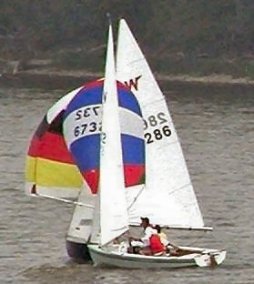 ... ...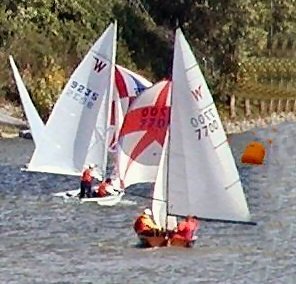 |
| In the photo on the left above, W6732 and
W286 are overlapped even though they are
on opposite tacks because both are "sailing more than ninety degrees from the
true wind". Once W9235 and W7700 (above
right) reach the zone
around the red mark I have "drawn in" (it was down there
somewhere - I know! I nearly hit it!!) the term overlap can be
applied between them because Rule 18 applies. So,
if Roger Shepherd (7700) can just turn on the
afterburners, he can get an overlap in time to
claim "mark room/water" from Brian Jeffs (9235).
... |
| Racing A boat is racing from her preparatory signal until she finishes and clears the finishing line and marks or retires, or until the race committee signals a general recall, postponement, or abandonment. |
| Al's note:
This definition is important since the the preamble to
Part 2 of the RRS (right-of-way rules and such like)
specifies that "a boat not racing shall not be penalized for
breaking one of these rules, except rule 14 when the
incident resulted in injury or serious damage, or rule 23.1". For
the common good, we are of course expected to obey all
these Rules whenever we are in the race area - even when
we can't be penalized for breaking them because we're not
actually racing. |
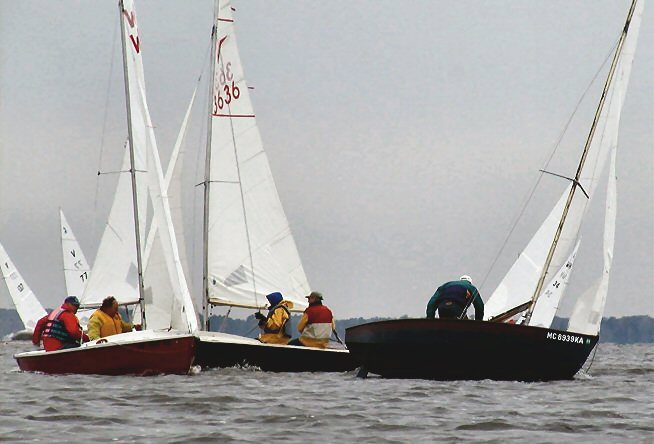 |
|
Above, W864 (Nick,
blue hull) has just tacked across the finish line
and has finished. But he has not yet "cleared the finish
line" and is therefore still racing. If Nick had
tacked a second or two later, he might have fouled Gale
Shoemaker (red hull). In that case, Nick
would have had to do his penalty turns and finish one
more time - this one to count!! Likewise, a
one-turn penalty followed by a re-finish will be
required, if Nick should hit the finish mark - even
after getting his “beep”.
... |
|
Al's
note: There is no longer a definition of "tacking" in our "new" Rules. The
old Rules more or less defined tacking as the
period of time from the moment a boat turns beyond
head to wind until she is on a close-hauled course.
That definition must now be inferred from Rule 13 as
follows:
13 While Tacking After a boat passes head to wind, she shall keep clear of other boats until she is on a close-hauled course.... For illustrated coverage of Rule 13, click here. ... |
| Room The space a boat needs in the
existing conditions, including space to comply with her
obligations under the rules of Part 2 and rule 31, while
manoeuvring promptly in a seamanlike way.
|
| Mark-Room
Room for a
boat to leave a mark on
the required side. Also, (a) room to sail to the mark when her proper course is to sail close to it, and (b) room to round or pass the mark as necessary to sail the course without touching the mark. However, mark-room for a boat does not include room to tack unless she is overlapped inside and to windward of the boat required to give mark-room and she would be fetching the mark after her tack. |
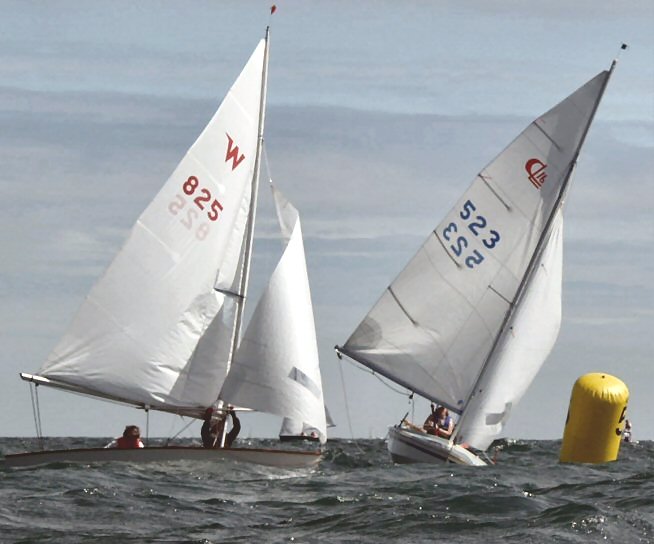 |
|
In the photo above, W825
(Ed Tait) is the leeward boat and has
right-of-way. Since CL523 (Colin Junkin) has an inside overlap
however, 825 is required by Rule 18 to give 523 mark-room.
This means that 523 is expected by the Rules and the
above definitions of room and mark-room,
to sail to the mark in a seamanlike manner,
i.e. keep his boat under reasonable control for the
conditions, get his board down in time for the upcoming
beat, get his sails in promptly and round as close to
the mark as prudence and good seamanship would indicate
in the prevailing conditions. In the conditions above,
with the mark and the boats bouncing around, 523 is
entitled to more room than he would be in 5
knots of breeze, flat water and no current. Once at the
mark, the new mark-room definition
entitles 523 to sail proper
course until he is no longer "at the mark",
at which point 523's mark-room protection ends
and he must again keep
clear of any right-of-way boat(s).
... |
| Keep Clear A boat keeps clear of a
right-of-way boat (a) if the right-of-way boat can sail her course with no need to take avoiding action and, (b) when the boats are overlapped, if the right-of-way boat can also change course in both directions without immediately making contact. |
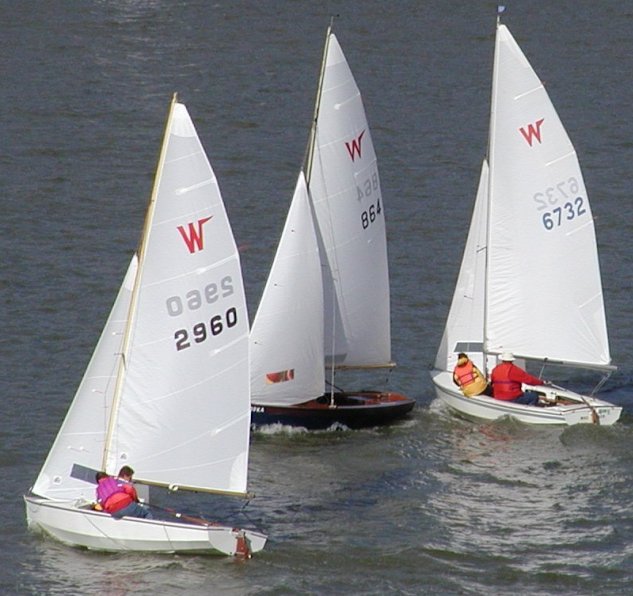 |
|
Above, Len Macdougall in
Wayfarer 6732 (on port tack) has kept clear of
Nick Seraphinoff in W864 who had no need to take
avoiding action. W2960, Don Thwing, on the other hand,
has reached the danger zone: Within the next second or
so, Nick in 864 will have to begin avoiding action or
face breaking Rule 14
in a possible collision with 2960. Unless 2960 tacks
immediately (or far more riskily, bears away radically now),
he will not be keeping clear of the starboard
boat, 864, and will have fouled the latter.
... |
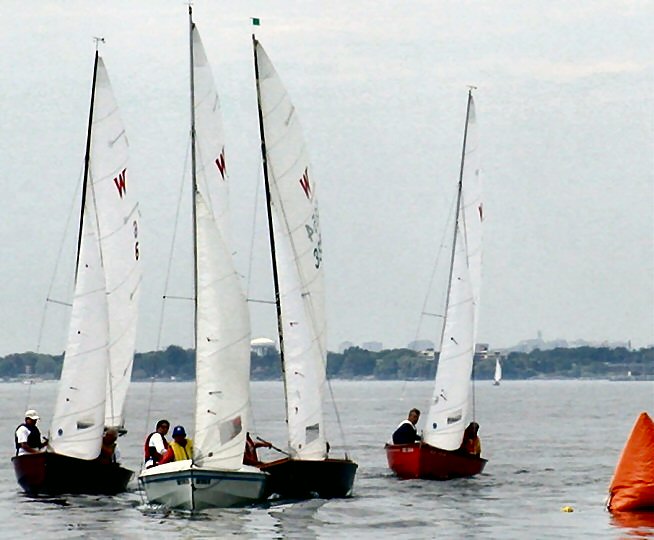 |
|
In the photo above, Marc
Bennett (W6) is keeping clear of Tanya Wharton
in the white-hulled Wayfarer to leeward of him,
but Tanya has sailed so close to W3854 that Uncle Al can
no longer "change course in both directions without
immediately making contact with the windward boat".
Ergo, Tanya is not keeping clear of 3854 and has
fouled Uncle Al under Rule 11.
... |
| Proper Course A course a boat would choose in order to sail the course and finish as soon as possible in the absence of the other boats referred to in the rule using the term. A boat has no proper course before her starting signal. |
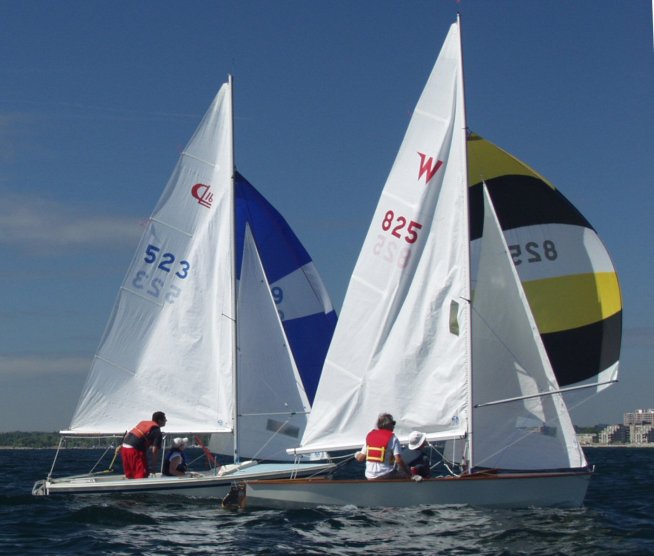 |
|
There is a widespread
belief that proper course is the same thing as
sailing the rhumbline (i.e. straight towards the next
mark) on anything except an upwind leg of the course.
This, in fact, is rarely the case. In the photo above
for example, Rule 17
requires Colin in CL523 not to sail above his proper
course because he became overlapped from clear
astern within two lengths of Ed (W825). But that
does not necessarily mean Colin must sail straight at
the next mark. He is simply required to sail the course
that he feels would get him around the course in the
fastest possible time "in the absence of the other boats
referred to in the Rule using the term", i.e. W825 would
be the "other boat" (the windward boat, in this case)
referred to in Rule 17.
..Here, Colin (CL523) can defend sailing high of the mark if he can convince the Protest Committee that because the spinnaker reach was quite close, he has been sailing high of the mark for some time since he wanted to make sure he would lay it. In other words, he would have sailed above the direct course to the next mark, even if Ed in W825 had not been there. |
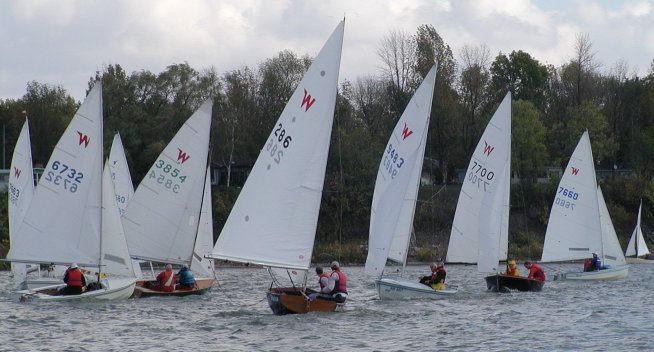 |
|
Before the start, we
have no particular place to go, and there is, logically
enough, no proper course before the
start signal is made. Therefore, Rule 17 which requires
sailing no higher than proper course in some
circumstances, does not "kick in" until after the start
signal has been made.
... |
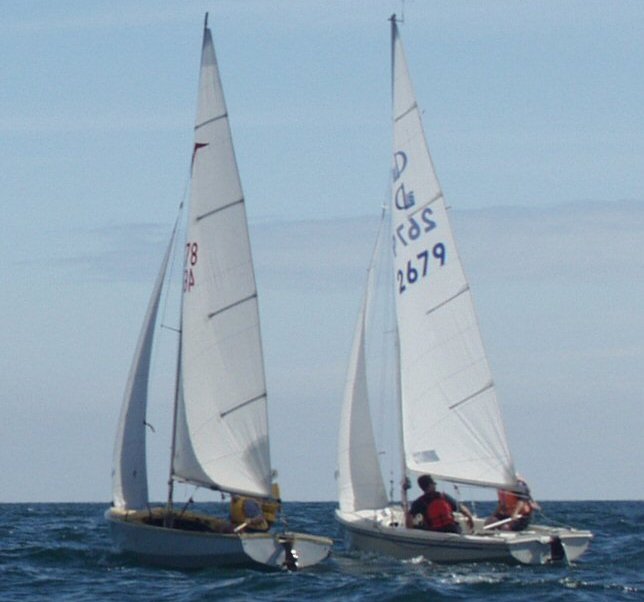 |
|
Upwind, proper
course is basically any close-hauled course that a
boat may choose to sail. Above, Chris Lansdown in W4678
(the leeward boat) can pinch as high as he likes
and Gary McIlroy in CL2679 (windward) will have
to keep clear.
Worrying about sailing
proper course upwind usually only happens just after the
start: Let us assume for example, that these two have
just started and that 4678 established a leeward overlap
from clear astern while 2679 was "sitting" on the line
with her sails luffing and waiting for the "gun". Once
the gun went, 4678 became subject to Rule 17 which limits
4678 to sailing no higher than his proper course. Thus,
W4678 had to bear away to close-hauled as soon as
the start signal was made but is entitled to sail her
proper course. If that is higher than 2679 is able to
point, tough beans!! (Al's note: this is not the
official ISAF terminology)
... |
| Obstruction An object that a boat could not pass without changing course substantially, if she were sailing towards it and one of her hull lengths from it. An object that can be safely passed on only one side and an object, area or line so designated by the sailing instructions are also obstructions. However, a boat racing is not an obstruction to other boats unless they are required to keep clear of her or, if rule 22 applies, avoid her. A vessel under way, including a boat racing, is never a continuing obstruction. |
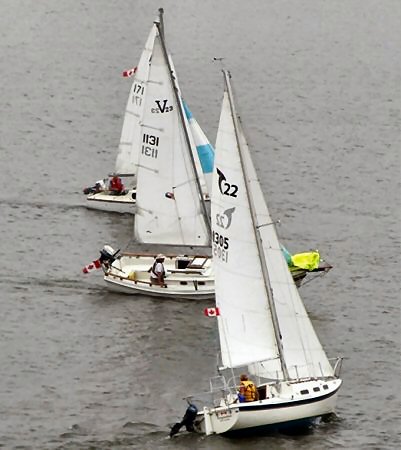 |
|
Apart from the obvious
but rarely met obstructions such as piers
sticking out in front of us or a ferry coming across,
the obstructions that we face most regularly
are right-of-way boats of which we must keep clear,
boats to whom we must give mark-room, or
capsized boats. The photo above illustrates a very
common situation: 1305 is on starboard. Since
both port boats will very soon have to take
avoiding action for 1305, she ranks as an obstruction
to both. The leeward port boat (1131) could have
called for "room to tack" for the obstruction (see
Rule 20) or
chosen to pass astern of the obstruction (1305).
If 1131 chooses the latter course, she must - under Rule
19 - give room
to 171 if the latter also wants to pass astern of
1305. It's very much as if 1305 were a moving mark.
... |
| Fetching A boat is fetching a mark when she is in a position to pass to windward of it and leave it on the required side without changing tack. |
Fetching the mark is
the same as “laying” it, i.e. being in a position to
round the mark without having to put in any more tacks.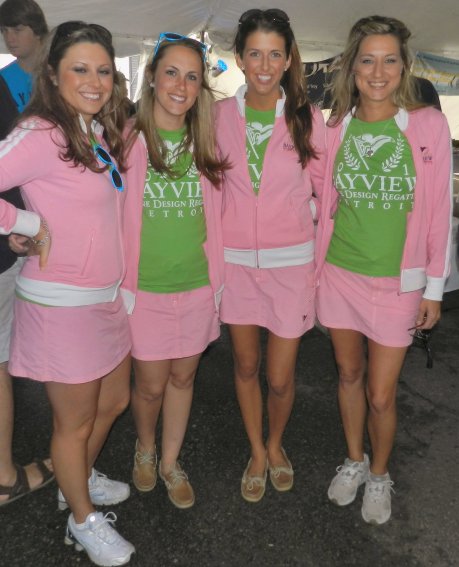 Fetching??!! Fetching :) You want fetching, I’ll give you fetching. The young ladies of the social committee (left) at the 2012 inaugural Bayview YC One-Design Regatta are very fetching indeed!” Or of course, Fido and Rover, too, are familiar with the word “Fetch”. 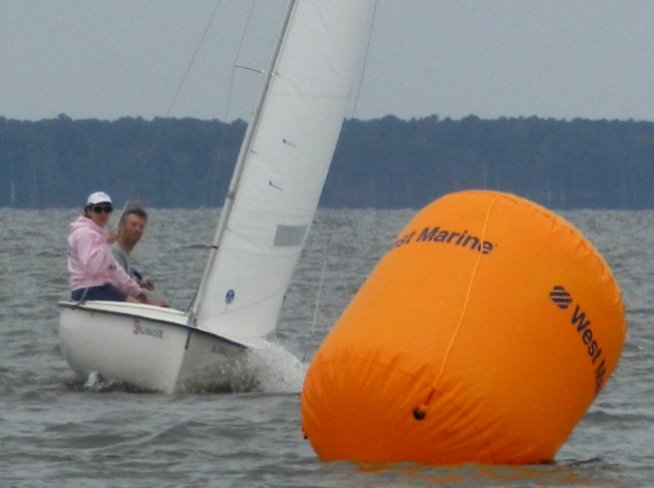 Actually,
“fetch” is what the Brits (and others?) say instead of
“lay” - as in “Can we lay it yet?” Even being
Canadian, I do find “fetch” useful though, when I need
to use it as a noun, e.g. “The beat had turned into a
fetch.” (= one-tack beat) where the noun “lay” might
sound odd to some.
(right) Greenwood Lake Rebel sailors, Bob and Jean Zimmer, look like they are fetching/laying the mark at Rock Hall 2012. |
| Finish A
boat finishes when, after
starting, any part of her hull crosses the
finishing line from the course side. However, she has not
finished if after crossing the finishing line she (a) takes a penalty under rule 44.2, (b) corrects an error in sailing the course made at the line, or (c) continues to sail the course. |
| definition: sailing
the course NOTE - "Crew or equipment in normal position" has been removed from the definition of Finish. |
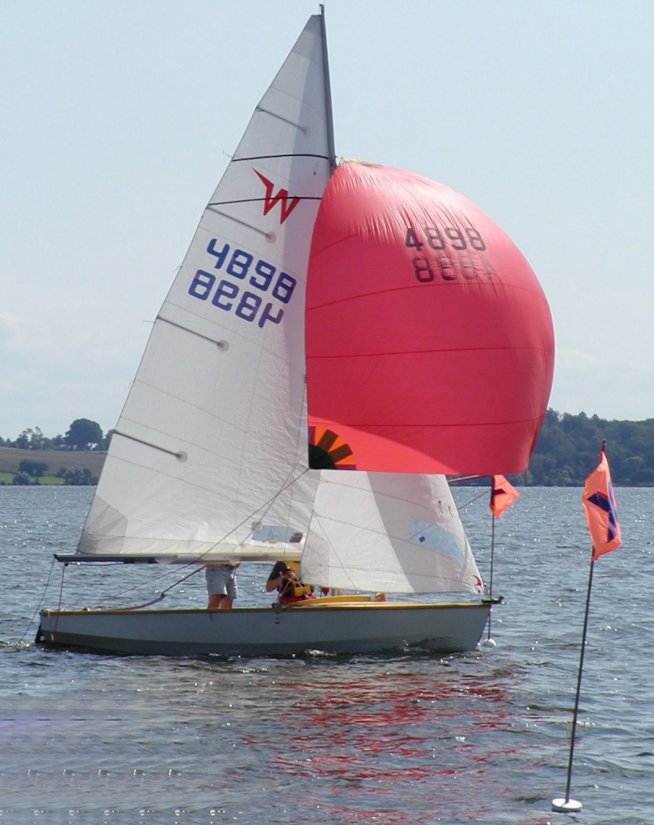 |
|
Stephan Nandrup-Bus
(W4898) finished just a split second ago when
the first part of his spinnaker broke the plane of the
finish line. If his spinnaker had been allowed to flap
loose to fly further forward, or if his crew - God
forbid - had been hanging off the bow with an arm
stretched forward, that would not have been gear
in normal position and the finish would have
been taken at the moment the first part of his boat that
was in normal position crossed the line - likely
his little mini-bowsprit (spinnaker sheet catcher).
... |
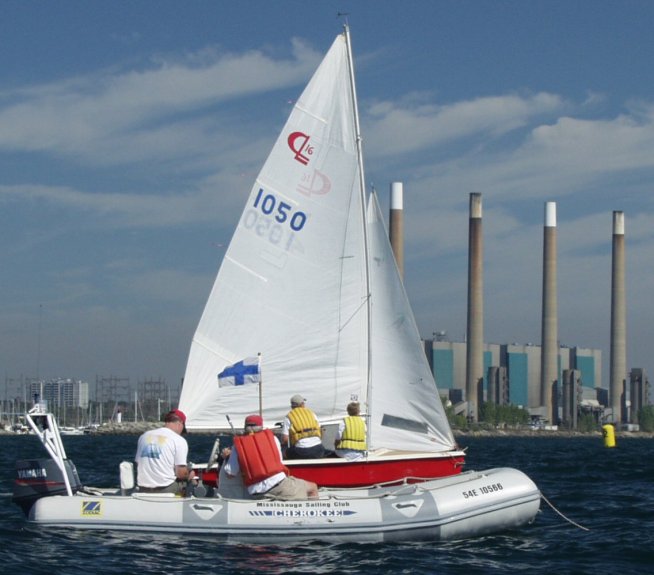 |
| If this were a "buoys to starboard" course, then this RC boat would be anchored on the "wrong" side for a "buoys to starboard" finish. This happens frequently for a variety of reasons, and is not, in itself, considered grounds for redress. The finish definition makes it clear that in such an instance, the side the mark was to be left on no longer matters, since a boat finishes when it "crosses the finishing line in the direction of the course from the last mark". Thus CL1050 (Rob Wierdsma with son, Ben) is finishing correctly in the photo above, regardless of whether it was a buoys to port or starboard course. |
|
Rules
in
Pictures index
Definitions
Defintions
PDFI have also made PDF's of the five items below - for those who want to print the material or work off line. These PDF's will not have the many links included in the on-line version, however. Part 2A Part 2A PDF Part 2B Part 2B PDF Part 2C Part 2C PDF Part 2D + penalty turns 2D PDF Photo-based Rules Quiz - 1 Photo-based Rules Quiz - 2 |